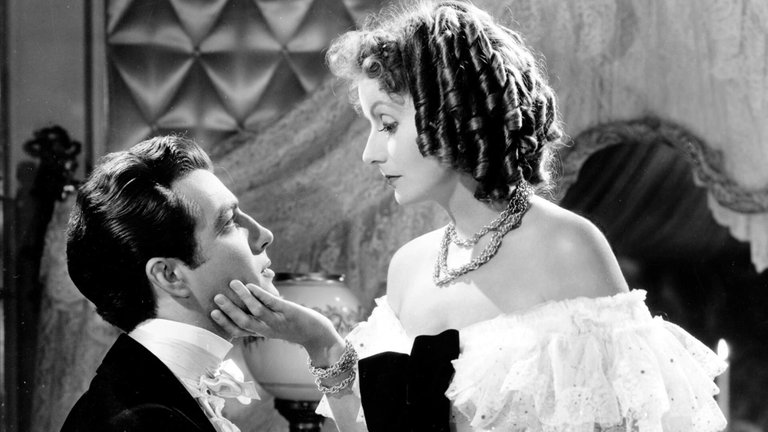Film Review: Camille (1936)

There are films that can leave you cold, although they are not supposed to, based on the talents involved and the reputation built and maintained through the decades. The author of this review experienced such a phenomenon with Camille, the 1936 romantic drama directed by George Cukor. The film is based on The Lady of the Camellias, a novel by French author Alexandre Dumas fils, which became one of the most popular works of 19th-century literature and was adapted countless times, including Verdi’s famous opera La traviata.
The plot takes place in 1847 Paris, where Marguerite Gautier (played by Greta Garbo), a woman of great beauty but extremely humble background, enjoys a reputation as one of the city’s top courtesans. One night at the theatre, while trying to catch the attention of a potential patron, the wealthy Baron de Varville (played by Henry Daniell), she mistakes him for Armand Duval (played by Robert Taylor), a dashing young man from a noble but impoverished family. By the time the mix-up is resolved, both Armand and Marguerite are hopelessly in love with each other. Marguerite is, however, worldly enough to know that she would be more financially secure with the Baron than with Armand. He nevertheless manages to win her over and bring her to the country, where she would live a simple but happy life with her young lover. But her bliss comes to an end when Armand’s father (played by Lionel Barrymore) begs her to leave him because a scandalous liaison with a woman of ill repute would wreck Armand’s public career and prospects in “polite” society. Marguerite agrees and breaks her and Armand’s hearts. Months later, Armand is ready to reunite with her, but Marguerite is dying of consumption.
Camille was made by Metro-Goldwyn-Mayer under the supervision of Irving Thalberg, one of the most talented producers of Classic Hollywood, who died during production. The film was directed by George Cukor, an immensely talented filmmaker who would gain a reputation as a “women’s director” due to his great work in melodrama and ability to get top performances from actresses. The actress in question was Greta Garbo, one of the most iconic stars of Hollywood, and her role as Marguerite is considered one of the best in her relatively short but memorable career. Garbo, who began her career in the silent era only to transition flawlessly to sound despite her heavy Swedish accent, shows a great deal of experience and delivers an almost flawless performance as a woman torn between conflicting desires – the hedonistic pursuit of pleasure under the shadow of an illness that might claim her at any minute, the genuine love she feels for a young man and, finally, a guilty conscience when she realises that her own happiness might bring misfortune to Armand.
Thalberg, Cukor and Garbo create a formidable combination of talents that results in Camille displaying Classic Hollywood at its best. While a very good film, Camille isn’t perfect, although it would be hard to blame the people involved in the production. Part of the problem lies in the literary source, which might look too melodramatic or too romantic for more cynical and jaded viewers in the 21st century. Another problem for this film is the heavy censorship of the Hays Code, which forced Cukor to walk a very fine line and try not to be explicit about what Marguerite actually does for a living and the true nature of her relationship with her “sponsors”. On the other hand, Cukor’s attempts to add some light humour while portraying the decadent set of Marguerite’s friends and “friends” from the Parisian demi-monde bring some lightness to an otherwise dour film, but this is much at odds with the more serious tear-jerking finale. Robert Taylor, while looking the part of a Classic Hollywood hero, at times has problems matching his own acting abilities to Garbo’s, although Cukor, with his direction, mostly succeeds in hiding such flaws. Camille was, despite all such flaws, immensely successful at the box office and is considered one of the most iconic melodramas of 1930s Hollywood.
RATING: 7/10 (+++)
Blog in Croatian https://draxblog.com
Blog in English https://draxreview.wordpress.com/
InLeo blog https://inleo.io/@drax.leo
Unstoppable Domains: https://unstoppabledomains.com/?ref=3fc23fc42c1b417
Hiveonboard: https://hiveonboard.com?ref=drax
Bitcoin Lightning HIVE donations: https://v4v.app/v1/lnurlp/qrcode/drax
Rising Star game: https://www.risingstargame.com?referrer=drax
1Inch: https://1inch.exchange/#/r/0x83823d8CCB74F828148258BB4457642124b1328e
BTC donations: 1EWxiMiP6iiG9rger3NuUSd6HByaxQWafG
ETH donations: 0xB305F144323b99e6f8b1d66f5D7DE78B498C32A7

nice to see older films being looked at
nice write up.
with the mores and restrictions of the era filmmakers had to be skilful in a way modern directors need not worry about.